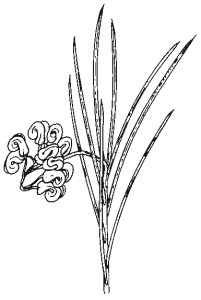Family:
Proteaceae
Grevillea rosmarinifolia
Rosemary Grevillea
(syn. G. glabella, G. divaricata)
Other Names:

Name Origin:
Grevillea — after Charles Francis Greville (1749-1809), co-founder of London Horticultural Society.
rosmarinifolia — from genus Rosmarinus and Latin folium, leaf, referring to similarity to herb rosemary.
Regional Subspecies:
Grevillea rosmarinifolia subsp. glauca, G. r. subsp rosmarinifolia
Occurrence:
Regional:
Noted in the areas: Maragle; Tooma and Paddy’s River-Burra Valley. Possibly also in areas surrounding those noted.
Australia:
NSW, Vic.
Habitat:
Woodland near streams and moist slopes. Also mallee and shrubland on plains and slopes, on sandy soil.
Habit:
Compact to open shrub 30 cm to 2 m high. Narrow prickly leaves.
Site Preference:
Well-drained soil in full sun. Tolerates frost and extended dry periods.
Characteristics:
Apparently commonly hybridises with Woolly Grevillea (G. lanigera). Also hybridises with Crimson Grevillea (G. polybractea), Fan Grevillea (G. ramosissima) and Green Grevillea (G. jephcottii). Moderate growth rate. Lifespan up to several decades.
Flowering:
Pink to red (sometimes with cream), mainly spring. Spider-like.
Seed Collection:
Early Dec – early Jan. Monitor closely as seeds shed soon after maturity. Follicles turn from green to brown at maturity. Ensure collection by securing nylon stockings or paper bags to fruiting branches after flowering. Usually only small portion of flowers set seed.
Propagation:
From seed, or cuttings which strike readily. Take cuttings 5-7 cm long from new growth with heels.
VALUES:
Shade & Shelter:
Excellent low-level cover in windbreaks.
Wildlife:
Excellent habitat. Dense prickly foliage excellent refuge for small birds, including finches and wrens. Nectar-rich flowers attract native birds, moths, butterflies and other insects.
Ornamental:
Attractive ornamental for screening, hedges, and under trees. Responds well to hard pruning and mulching.
Other:
Flowers and leaves produce lemon-yellow dye with mordant alum, and flowers alone produce fawn-gold dye.
